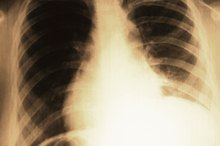What Causes Scarring of the Lungs?
Scarring of lung tissue causes a variety of problems, from difficulty breathing to lack of adequate oxygen intake for optimal function of body organs. Understanding the causes of lung tissue damage helps you make wiser choices about your lifestyle habits. Damage to the bronchi, the two major airways to the lungs; the bronchoiles, the smaller branches of airways; or the alveoli, the small air sacs, may be affected by lifestyle, disease and environmental factors, which can lead to scarring of the lungs.
If you are experiencing serious medical symptoms, seek emergency treatment immediately.
Toxins
Long term exposure to pollutants in the air may lead to lung damage and scarring. For example, metal dust shavings, asbestos or inhaling silica dust particles are environmental hazards of working in the construction industry. A pool cleaner who continually inhales chlorine or acid fumes may also experience some scarring of lung tissues. Farm workers exposed to chicken droppings or dust, moldy hay dust particles or grains grown in crops also face risks of lung damage, according to the Mayo Clinic.
- Long term exposure to pollutants in the air may lead to lung damage and scarring.
- A pool cleaner who continually inhales chlorine or acid fumes may also experience some scarring of lung tissues.
Radiation Therapy
Atelectasis Vs. Scarring
Learn More
If you have been diagnosed and treated for lung cancer with radiation therapy, you may also suffer some lung damage caused by scarred tissues. The degree of damage is determined by the length and duration of radiation treatments and whether or not the person was also treated with chemotherapy drugs congruent with the radiation therapy. Some chemotherapy drugs also cause damage and scarring to the membranes lining and protecting the lungs, according to the Mayo Clinic.
Pulmonary Fibrosis
Idiopathic pulmonary fibrosis is caused by a gradual thickening of lung tissues, according to the Pulmonary Fibrosis Foundation 2. Fibrosis is a medical term for scarring, and idiopathic means there is no known cause for the condition 2. This thickening leads to large areas of scarring and prevents the affected lung tissues from properly receiving, exchanging or transferring vital oxygen to all parts of the body. Idiopathic pulmonary fibrosis is one of many types of interstitial lung disease processes, which may potentially lead to damage or scarring to the lungs 23.
Pneumonia
What Causes Hardening of the Lungs?
Learn More
A great majority of lung scarring cases may be caused by pneumonia, according to the University of Maryland Medical Center.
Related Articles
References
- Mayo Clinic: Interstitial Lung Diseases - Causes
- Pulmonary Fibrosis Foundation: What is Idiopathic Pulmonary Fibrosis?
- MedlinePlus: Diffuse Interstitial Lung Disease
- Antoniou, K., Tomassetti, S., Tsitoura, E., and C. Vancheri. Idiopathic Pulmonary Fibrosis and Lung Cancer: A Clinical and Pathogenesis Update. Current Opinions in Pulmonary Medicine. 2015;21(6):626-33.
- George, P., Patterson, C., Reed, A., and M. Thrillai. Lung Transplantation for Idiopathic Pulmonary Fibrosis. Lancet Respiratory Medicine. 2019;7(13):271-82.
- Ghebremariam, Y. et al. Pleiotropic Effect of the Proton Pump Inhibitor Esomeprazole Leading to Suppression of Lung Inflammation and Fibrosis. Journal of Translational Medicine. 2015;13:249.
- Hutchinson, J., McKeever, T., Fogarty, A., Navaratnam, V., and R. Hubbard. Increasing Global Mortality From Idiopathic Pulmonary Fibrois in the Twenty-First Century. Annals of the American Thoracic Society. 2014;11(8):1176-85.
Writer Bio
Denise Stern is an experienced freelance writer and editor. She has written professionally for more than seven years. Stern regularly provides content for health-related and elder-care websites and has an associate and specialized business degree in health information management and technology.









